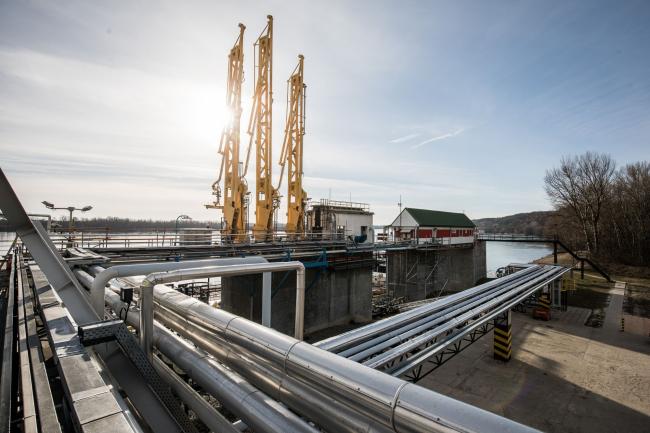(Bloomberg) -- OPEC stood on the verge of a deal to cut its official production target, but after six hours of fraught talks in Vienna on Thursday ministers left the cartel’s headquarters before a final agreement was nailed down.
Saudi Prince Abdulaziz bin Salman, in his first meeting as energy minister, left reporters with a promise of “beautiful news tomorrow.” His comments were the culmination of a long day that yielded little concrete for oil traders wondering if the Organization of Petroleum Exporting Countries and its allies would take action to prevent a crude surplus coming back in 2020.
Earlier in the day, ministers reached a deal in principle to deepen their output-cuts target by 500,000 barrels a day, delegates said. A reduction of that magnitude would be largely symbolic, simply formalizing the extra supply reductions the group has already been making for most of this year, rather than taking barrels off the market.
Saudi Arabia’s new production target was likely to be above 10.1 million barrels a day, said one delegate, slightly higher than recent levels.
Click here for an explanation of why a deeper OPEC+ cut would not be quite what it seems.
Even so, the cartel couldn’t find a way to divide the adjustment between members before further discussions with partners from the wider OPEC+ group on Friday, delegates said. The new production target for Iraq, which has the worst record of implementing the existing cuts of any major oil producer in the Organization of Petroleum Exporting Countries, was a particular sticking point, delegates said.
“The OPEC meeting that a priori was supposed to deliver a relatively easy decision on an extension of supply cuts likely overreached,” said Harry Tchilinguirian, head of commodity market strategy at BNP Paribas (PA:BNPP) SA. “Extending into deeper cuts exposed the difficulties that were known in advance, namely the lack of appetite to cede further market share.”
Brent oil lost 5 cents to $63.34 a barrel in London as of 9:02 a.m. Singapore time after climbing 0.6% on Thursday. Futures in New York were little changed at $58.41 after gyrating through the previous session before closing unchanged.
Compliance Pressure
In any event, OPEC’s policy decision wouldn’t have been officially ratified until Friday, when the OPEC+ meeting was scheduled. But unresolved questions around Iraq’s contribution could be a bigger obstacle to a deal than usual.
Crucially, the new 500,000 barrel-a-day quota reduction, which would apply in the first quarter of 2020, would come only into force if all members of OPEC+ implement 100% of their pledged curbs, Russian Energy Minister Alexander Novak said in a Bloomberg TV interview. That’s something the alliance has struggled to achieve throughout the three years of its existence, with some countries such as Iraq actually increasing output after promising to cut.
OPEC+ agreed last year to reduce output by about 1.2 million barrels a day in order to eliminate a surplus and bolster crude prices. In reality, the alliance has cut far deeper for most of 2019 due to a combination of voluntary and involuntary measures. The group’s Joint Technical Committee concluded that supply reductions exceeded that target by about 40% in October, equivalent to about 500,000 barrels a day of additional curbs.
Saudi Arabia, wishing to lead by example, has pumped well below its quota of 10.3 million barrels day for the duration of the agreement. The kingdom’s output averaged 9.8 million so far this year, according to data compiled by Bloomberg. Other nations including Angola, Azerbaijan and Mexico have simply been unable to sustain their production due to natural declines.
The deal expires at the end of March, right in the middle of what looks to be a tricky patch for the oil market. Demand growth is slowing and another big expansion in rival production is coming down the pipeline.
Together those factors could create another oversupply that drives international prices back down toward $50 a barrel. That’s too low for most OPEC members to balance their budgets, and would make an unfortunate epilogue for the record-breaking initial public offering of Saudi Arabia’s state oil company, Aramco.
Compliance Pressure
The emphasis on compliance with the production cuts reflects Saudi Oil Minister Prince Abdulaziz bin Salman’s unhappiness with the status quo, in which countries including Iraq, Nigeria and Russia have consistently failed to implement their promises.
“The kingdom has explicitly communicated to OPEC that it will no longer tolerate under-compliance,” Amrita Sen, chief oil analyst at Energy Aspects Ltd., said before the committee meeting. “If it continues, Saudi Arabia can easily return to producing at or above its current quota.”
For Russia, which has achieved its targeted cuts in just three months this year, full compliance got easier on Thursday as OPEC agreed to exclude a very light oil called condensate from the country’s quota. Novak had argued that a recent increase in production of that hydrocarbon, which is extracted from natural gas, was the only reason Russia was falling short of its pledge.
Nigeria and Iraq have actually increased output, according to data from the International Energy Agency. Those two nations might be the only ones who have to adjust production as a results of Thursday’s deal, Roger Diwan, the veteran OPEC watcher at consultant IHS Markit Ltd., said from the sidelines of the meeting in Vienna.
“It’s a rollover for everyone but Iraq and Nigeria,” Diwan said.
(Updates oil prices in seventh paragraph.)
